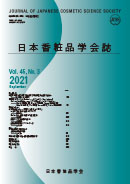45 巻, 3 号
選択された号の論文の7件中1~7を表示しています
- |<
- <
- 1
- >
- >|
一般論文
-
2021 年 45 巻 3 号 p. 185-190
発行日: 2021/09/30
公開日: 2022/09/30
PDF形式でダウンロード (722K) -
 2021 年 45 巻 3 号 p. 191-200
2021 年 45 巻 3 号 p. 191-200
発行日: 2021/09/30
公開日: 2022/09/30
教育セミナー:第45 回教育セミナー(2020)・「角層のサイエンス」
-
2021 年 45 巻 3 号 p. 201-208
発行日: 2021/09/30
公開日: 2022/09/30
PDF形式でダウンロード (1739K) -
2021 年 45 巻 3 号 p. 209-214
発行日: 2021/09/30
公開日: 2022/09/30
PDF形式でダウンロード (1166K) -
2021 年 45 巻 3 号 p. 215
発行日: 2021/09/30
公開日: 2022/09/30
PDF形式でダウンロード (186K) -
2021 年 45 巻 3 号 p. 216
発行日: 2021/09/30
公開日: 2022/09/30
PDF形式でダウンロード (169K)
寄稿:これまでの研究を振り返って
-
2021 年 45 巻 3 号 p. 217-219
発行日: 2021/09/30
公開日: 2022/09/30
PDF形式でダウンロード (422K)
- |<
- <
- 1
- >
- >|
